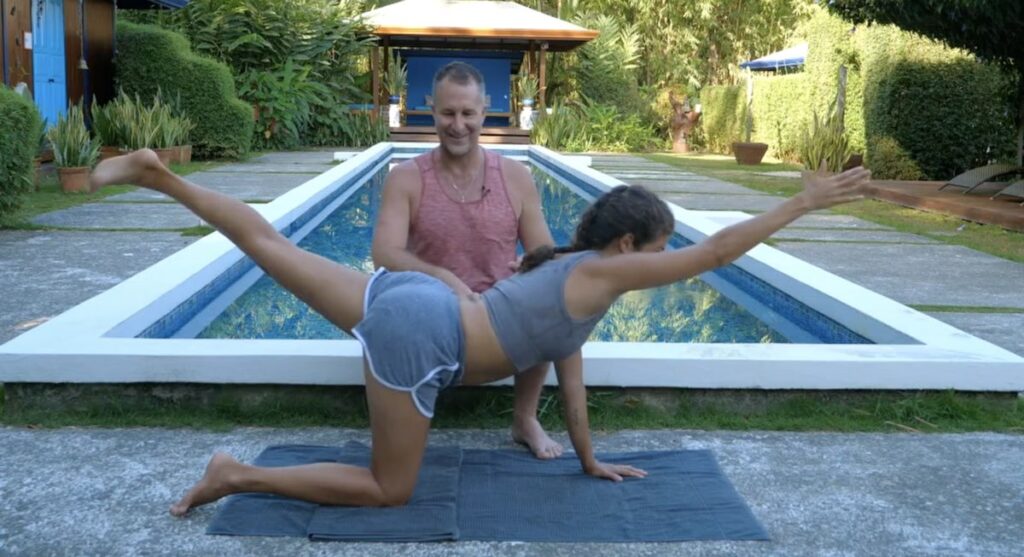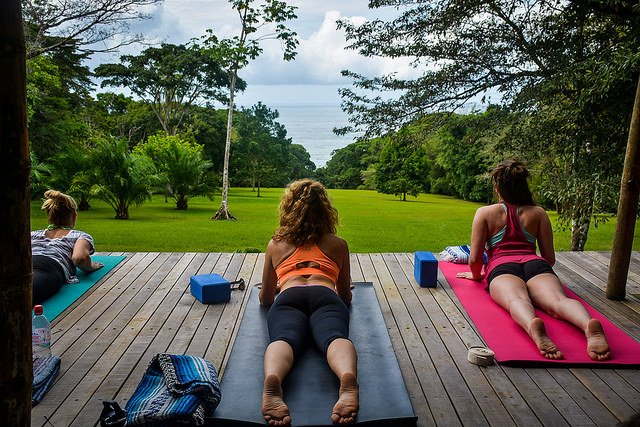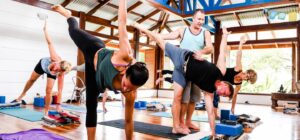Beyond the buzzword, Muscle Activation Technique™ (MAT) is a powerful way to improve your physical health and overall well-being.
Have you heard the whispers about MAT muscle activity therapy? Ever since famed quarterback Peyton Manning credited MAT for his recovery, hands-on manual therapy has exploded in popularity.
It’s hardly any secret that fitness trends come and go. However, I’ve been teaching Applied Yoga Anatomy + Muscle Activation™ in my yoga classes for some time now, and I’m here to tell you this: If you want to cure physical pain and build a strong and stable body, then it’s time to incorporate Muscle Activation Techniques into your yoga practice.
Before we dive into the benefits of Muscle Activation Techniques, let’s quickly review the MAT method and how it works.
What is Muscle Activation Therapy or MAT?
MAT is a massage therapy method used to analyze and correct muscular imbalances, joint instability, and limitations in range of motion.
Rather than relaxing or stretching the muscles, we work on “firing up” the muscles to re-establish their communication pathways to the nervous system. As a result, we restore muscle contractile capabilities and improve range of motion.
If you see a Muscle Activation therapist, they’ll apply pressure in a specific way to reactivate the muscle. When it comes to your yoga practice, there are Applied Yoga Anatomy + Muscle Activation™ exercises you can do to target weak muscles, too.
If you’re new to MAT in yoga, it might be different from anything else you’ve experienced. Check out this video for beginners. I use MAT training to help students activate the glute muscles for increased mobility.
Start with this Muscle Activation for Beginners yoga class.
Note: Even if you don’t do the whole class, go watch the first 12 minutes. You’ll see the mind-blowing results of MAT in action.
How Muscle Activation Techniques Can Combat Physical Pain
Do you experience acute physical pain? If so, you’re not alone. Nearly 40 million adults live with severe levels of pain.
But why do so many of us experience pain – and what can we do about it?
It’s a complex question, one I won’t pretend to solve in only a few thousand words. But I do want to address one specific cause of physical pain: muscle dysfunction.
Muscle deterioration is a sign of aging. Keep the muscles activated, and we fight aging – and reduce chronic pain and injury, too.
The first sign of muscle dysfunction is tightness. Pain then follows.
When we re-establish communication between the muscles and the central nervous system, we can “fire” up the muscle to resolve tightness and reduce (and even eliminate) pain.
Only by repairing the communication between the muscles and the central nervous system can we start to address the underlying issue in the body – and fix it for good.
In other words, muscle activation is a technique to jump-starting your muscles.
Why Stretching Doesn’t Work, but Muscle Activation Does
Yoga teachers are obsessed with stretching, despite ample evidence that stretching incapacitates muscle function. And why? There’s absolutely no mention of the benefits of stretching or flexibility anywhere in the Yoga Sutras or Hatha Yoga Pradipika.
Here’s the thing:
Flexibility inevitably leads to instability. And where there is instability, injury is sure to follow.
Instead of worrying about how deep we can move into a posture, it’s time to build solid and stable muscles that can withstand the stress of physical activity and reduce chronic pain you’ve been living with. MAT techniques are a great starting point to do exactly that.
8 Benefits of Applied Yoga Anatomy + Muscle Activation in Yoga (MAT)
Let’s take a closer look at the proven benefits of Muscle Activation Techniques in yoga. Then, I’ll share a few of my favorite MAT video tutorials so you can start practicing the method today.
1. Reduced pain
We touched briefly on this above, but it bears repeating: MAT is a powerful way to reduce and even eliminate pain.
When you’re in pain, you don’t want a quick fix to your problem. You want a solution. With the proper muscle activationj instructions, it’s possible to reactivate and re-establish communications with the nervous system to cure pain and reduce the risk of future injury.
Our bodies experience stress, trauma, and overuse. It’s part of life. But over time, this causes altered communication between the nervous and muscular systems, triggering muscle tightness, pain, and aging in the body.
MAT works to re-establish communication pathways and activate the muscles to release tightness and reduce this pain while equipping the muscles to handle everyday forces and stresses.
Check out this video for an easy-to-understand tutorial on how unactivated muscles can cause pain in the body — and a quick hack to fix it using muscle activation techniques.
2. Improved Range of Motion
Want to improve your range of motion?
Stretching or otherwise forcing the muscles to move in a certain way is not the answer.
Instead, we can use MAT to reactivate muscles that aren’t working correctly, bringing the body closer to symmetry. When your muscles are functioning correctly and working harmoniously, the range of motion throughout the body improves.
Many of my yoga students want to “open the hips.” But again, stretching and forcing the hips to open will not create stable, injury-proof hips.
So, I taught this 75-minute Applied Yoga Anatomy class to open and stabilize the hips. Give it a try and notice how you feel in your body afterward — you might be shocked by the difference.

3. Muscle stability
Yoga is the practice of coming home in our bodies – of cultivating self-awareness, discernment, and higher consciousness.
That said, yoga postures do matter.
Patanjali says that to find enlightenment, we must have a stable mind. And how do we quiet the mind? By stabilizing the body.
If we are physically sick, we can’t focus on growing spiritually. We’re too busy trying to remove the pain.
This is why I’m so passionate about helping my students alleviate pain – so you feel good in your physical body, but can refocus your attention towards growing spiritually, too.
4. Improved Alignment
If you have a weak muscle, your body will naturally compensate by making other muscles work harder. Over time, this can lead to injuries and imbalances.
Correct alignment enables the body to fully open without stretching or pushing it where it doesn’t want to go, thus minimizing wear and tear on the joints and tissues.
Muscle Activation Techniques help to improve alignment and muscle balance by activating and strengthening weak muscles and, ultimately, prevent the return of tightness or pain.
Combine MAT therapy with mind, spirit, and bodywork, and you’ll experience improved alignment in all aspects of your life.
5. Lower Risk of Injury
With Muscle Activation Techniques in yoga, we’re not just working to remove the pain but to reduce the risk of experiencing an injury in the first place.
When you improve your range of motion, alignment, and muscle stability, you create an environment in the body that can better withstand life’s stresses.
When you’re young and fit, it’s easy to think you don’t need to worry about stabilization and mobility. But, speaking from experience, prevention is always much more manageable than treatment.
Incorporate Muscle Activation Techniques into your yoga practice today so you won’t have to deal with painful and aggravating injuries later.
6. Increased Strength
If a muscle is too weak to stabilize a joint, the brain will communicate with other muscles to get the job done. The only problem? That means some muscles are overworked while others are doing very little at all.
When you reactivate weak muscles, your brain begins communicating more effectively. And if you suddenly start using twice the muscles for the same activity? Well, you could double your strength.
7. Improved Performance
Are you an athlete looking to improve your performance? Or maybe you’re just a fitness enthusiast who wants to shave a few seconds off your mile? Either way, MAT can help.
If you want your muscles to function at peak performance, the neurological connections must be intact. Otherwise, the muscles might not tolerate the forces related to the exercise.
MAT exploded in popularity thanks to the professional sports world. If Muscle Activation Techniques are working for some of the best athletes in the world, then I’m going to pay attention.
8. Improved Lifestyle
The greatest wealth is health.
It’s more than a motivational quote. The older I get, the more I value my health and wellness – and the more I want to help my students eliminate pain for a more rewarding, fulfilling life, too.
If you could prevent muscle deterioration and aging in the body so you can do more of the things you love without pain or injury, well… why wouldn’t you?
What are good Muscle Activation Technique exercises?
You don’t have to see a MAT therapist to experience the benefits outlined above. Many Muscle Activation Techniques are accessible from the comfort of your yoga mat.
To help you start incorporating MAT into your yoga practice today, I’ve created a special playlist of ten Applied Yoga Anatomy + Muscle Activation Technique classes.
From learning how to activate opposite muscles to using MAT to deepen into classic yoga poses, these videos will give you a strong understanding of yoga anatomy. You’ll also leave with an awareness of what activating weak muscles should feel like so that you can reap the benefits of Muscle Activation Techniques today.
Final Thoughts
Have you ever taken a yoga class only to throw your back out or pinch a nerve? I know I have. But these days, the story is a little different.
Now, I’m committed to helping my students strengthen and stabilize through Applied Yoga Anatomy and Muscle Activation, so they can stop feeling pain and discomfort — and experience mobility and relief instead.
So, let’s quickly recap. The benefits of Muscle Activation Techniques in Yoga include:
- Reduced pain ✅
- Improved range of motion ✅
- Muscle stability ✅
- Improved alignment ✅
- Lower risk of injury ✅
- Increased strength ✅
- Improved performance ✅
- Improved lifestyle! ✅
Ready to experience these benefits first-hand? Want to enhance your yoga classes and support your students with Muscle Activation Techniques? Check out my free webinar on muscle activation for tips on how to get rid of pain and refocus your energy.

















